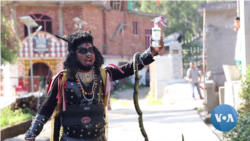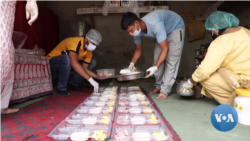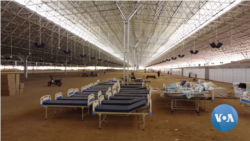When India was grappling with the pandemic last year, villages perched on Himalayan slopes remained in serene outposts, largely untouched. But the deadly second wave did not spare these far-flung regions.
“Entire villages were infected. In fact, the virus reached places at over 2000 meters,” said Rakesh Prajapati, the Deputy Commissioner of Kangra. “Rural centers were badly hit this time.” Kangra is the largest district in the mountainous Himachal Pradesh state.
Health experts blame a number of factors for India’s second wave. Among them are a more transmissible variant, super spreader events such as big public gatherings and laxity in following COVID protocols. In Himachal Pradesh too, public health experts have pointed to large wedding functions that were held in the days before infections spiraled.
As health facilities were inundated, authorities scrambled to contain the infection. They used some unusual initiatives to spread the message about following COVID protocols — in village lanes, street artists in black costumes enacted the threat posed by the coronavirus if residents did not use masks or follow measures such as sanitizing hands. A strict lockdown was enforced with police handing out penalties to those violating norms such as social distancing.
The second wave has ebbed in recent days with daily cases reducing significantly.
But the severity of infections and death toll was much higher compared to the first wave, according to officials. “This time we got disproportionate number of cases compared to our hospital infrastructure. So, we had to raise the capacity of our hospital beds, from 150 to 1,500 and we also had to increase ventilators, ICU (Intensive Care Unit) beds,” said Prajapati.
With hospitals stretched to capacity, authorities asked hundreds of infected people to isolate at home. But that was a challenge for many.
“If you have one or two rooms and one washroom, how do you isolate,” asked Sudhir Sharma, a resident who set up beds in a house he owns for people stricken with the virus.
He launched a helpline called “Shakti” on realizing how tough handling the infection was for patients after his driver tested positive. “When I asked him where he would stay, he told me he would pitch a tent outside his home. That is when I understood the predicament people face in villages.”
Meals were cooked and distributed to families where several members were sick, and kits of sanitizers and basic medicines handed to the sick.
Sharma’s was one of the countless civil society initiatives in India that have been on the frontlines of providing care and relief to people affected by the deadly second wave that crushed health care systems, even in big cities like Delhi, and left the country’s vast rural areas scrambling for even the most basic healthcare.
Himachal Pradesh, which has a better primary healthcare system compared to some other states, fared better. A network of healthcare workers helped distribute food rations to affected families in remote hamlets and monitored sick people. Known as “Asha” workers, they are usually the first point of contact in rural India for health services.
“We went from house to house and explained about coronavirus to them. We told sick people to keep up their spirits and the illness will pass away,” said Sanjana Andoria, the head of the local council in Kaliara village. It was not easy when the numbers of infected people were high — there are six healthcare workers in the village of 3,200.
While the first wave was followed with widespread complacency that the pandemic had passed away, this time authorities say they are taking no chances even though infections have plummeted. Amid forecasts by government scientists that a third wave will hit India later this year, isolation facilities with oxygen support are being ramped up — reaching oxygen to remote villages had been a challenge.
Campaigns to reinforce the need to follow COVID protocols will also continue as public health experts stress that these basic measures remain the most effective way to prevent outbreaks in a country where less than 5% of the population has been inoculated due to vaccine shortages.
Concerns are higher as studies find that the Delta variant that first emerged in India and was the predominant strain during the second wave in some parts of the country could be 50% more transmissible compared to one found in Britain earlier.
“Definitely the second wave will teach a lot of lessons to everybody — to the government, to the system and in fact the public at large. Had we been more careful and disciplined by way of maintaining social distancing, wearing masks etc., sanitization and hygiene, we could have prevented a lot of deaths and a lot of active cases,” Prajapati said.
Residents like Sharma say it was “heartbreaking” to witness that devastation in the countryside where he grew up.
“So many young people in their twenties in their thirties, they passed away,” Sharma said. “Every morning I got calls about people dying. I have never wept in my life, but I used to cry hearing such news.”
Although a sense of calm has returned as fewer infections are reported, fear and nervousness still lurk along Himalayan slopes.















